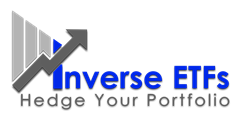Hedging Exchange Traded Funds
 The shift towards ETFs, exchange traded funds, investing over the last few years may have lulled many investors into a trap. It might seem confusing to use an inverse ETF to hedge against an ETF. Many ETFs have been marketed as having better liquidity and lower costs than mutual funds so there has been a rush towards them in the last few years. Mutual funds still dominate in terms of total assets under management ($10 trillion vs $3 trillion) but ETFs have narrowed the gap.
The shift towards ETFs, exchange traded funds, investing over the last few years may have lulled many investors into a trap. It might seem confusing to use an inverse ETF to hedge against an ETF. Many ETFs have been marketed as having better liquidity and lower costs than mutual funds so there has been a rush towards them in the last few years. Mutual funds still dominate in terms of total assets under management ($10 trillion vs $3 trillion) but ETFs have narrowed the gap.
The liquidity promise is starting to become challenged for ETFs. Ironically, some ETFs have been marketed as having a liquidity advantage over mutual funds in that they can be traded intra-day whereas mutual funds only ‘trade’ after the close of trading at one price for everyone, its net asset value. While this is true, ETFs, especially highly concentrated ones like XLF or QQQ, should not be considered liquid. Many market makers don’t take inventory risk like they used to as a result of many different forces, primarily regulatory.
We fear that even some alternative ETFs have similar risk profiles to traditional ETFs. They act like a diversified investment portfolios, but in the end they are still all ‘long’, just across different assets, kind of like the standard portfolio funds of funds. They may represent a safer alternative to traditional exchange traded funds but should be carefully reviewed before inclusion in a portfolio. Just like with stocks, some are better than others.
Concentration Risk in Exchange Traded Funds
Additionally, some ETFs are have very high concentrations in a few individual stocks. For an investor with a low risk tolerance, this could be dangerous for a few reasons. This over-concentration can be dangerous for a couple reasons. Apple and Google make up over 20% of the NASDAQ 100 ETF, QQQ.*
1- You are at risk if the largest component of the ETF gets into trouble. In some highly concentrated ETFs, some stocks comprise almost 20% of the entire fund.
2- Illiquidity-We saw examples of some ETFs trading at outrageous prices back in August of 2015. Popular ETFs like QQQ, XLF and IBB traded at outrageously low prices. Even the ‘low volatility’ ETFs like SPLV showed they are not low volatility as they are marketed.
Yes, the stocks in the fund may have had historically lower volatility than the overall market, but the ETF is only as liquid as it’s market makers conviction. When one of the larger components of a highly concentrated ETF is unable to open for trading, it is difficult for the ETF itself to open for trading. This is what happened as market-makers seemingly stepped away from quotes in the early part of trading. Since the underlying
In other words, you won’t be as diversified as you think. A stock like Apple is in so many ETFs and mutual funds own Apple shares that a short or buying put options on Apple would be a decent hedge if you only had one stock to use. You’re really just reshuffling the deck with the same stocks just in different ETFs with slightly different weightings. This is a failure to diversify. If you are aware of these risks and still want to take them, that’s fine. But if you have a low risk tolerance, you should be aware that ETFs may not make your portfolio as liquid and diversified as you thought and may not be suitable investments for your particular situation.
Every ETF, no matter what kind has risk. The only way to truly eliminate ETF risk, as opposed to market risk, is to raise cash. Even an inverse ETF could have serious problems and be forced to liquidate if the counterparties that are guaranteeing the return go under. Will the OCC step in (assuming the derivatives are cleared)? If we get to that level, only cash notes, bitcoins, water and ammunition will represent a diversified portfolio.
http://www.zacks.com/funds/etf/QQQ/holding


